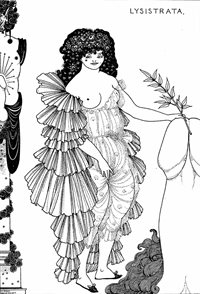3b. Ancient Greece
The world of ancient Greece (approximately 10th century BCE to 1000 CE) was full of violent conflict between warring states, but it also offered some fascinating messages about conflict resolution and peace. We will look at two examples – sex and sport. Have I got your attention?
Lysistrata

Beardsley, 1896
If you read Gene Sharp’s list of 198 Methods of Nonviolent Action in the introductory module, you may recall method #57 called “Lysistratic nonaction.” Probably this had no meaning for you. What Sharp was referring to, euphemistically, was a sex strike. This is a form of protest utilized mainly by women, as a means of exacting certain kinds of behaviour from men, which dates back to ancient Greece.
The basic story goes like this: Lysistrata was actually a play written by Aristophanes and first performed in Athens in 411 BCE. Some describe it as the first recorded successful anti-war campaign. The heroine’s name Lysistrata means “the one who undoes armies.” In the midst of warring between the city states of Athens and Sparta, Lysistrata and her followers seized the Acropolis and the treasury of Athens on behalf of all the women of Greece. Then women on both sides of the conflict declared a sex strike until the men of Greece ended the war. One might view this as an early manifestation of the ‘make love, not war’ theme!
The Lysistrata play and its themes had a resurgence in 2003 in response to the United States attack on Iraq in the aftermath of the 9/11 crisis. On March 3, 2003, the ‘Lysistrata Project’ as it was called, organized the performance or reading of the play in fifty-nine countries, as a statement of opposition to the war on Iraq. On or around that day, there were over 1,000 readings of the play. As well, there was a letter-writing campaign to the U.S. First Lady Laura Bush, encouraging her to withhold sex from her husband President George Bush.
In keeping with the Lysistratic tradition, sex strikes have occurred in various parts of the world as a method of social protest and often with the goal of ending a conflict. There is where the ancient world model continues to influence the present.
Here are a few recent examples:
-
Leymah Gbowee
© The Nobel Foundation
In 2003 in Liberia, a group called Women of Liberia Mass Action for Peace organized a series of nonviolent actions, including a sex strike, and demanded an end to the fourteen-year civil war that terrorized the country. The group's leader, Leymah Gbowee, received the Nobel Peace Prize in 2011. We will learn more about her in Module 10.
- In 2006 in Colombia, women undertook a ‘crossed legs’ campaign to protest the escalation of weapons and gang-related violence in their city of Pereira.
- In 2009 in Kenya, more than twenty women’s groups – from lawyers to prostitutes and including the Prime Minister’s wife – held a week-long sex strike to protest political corruption and violent ethnic conflict that emerged after elections in 2007.
- In 2011 in the Philippines, women successfully ended violence in their communities when they called for a sex strike: for a first-hand perspective, watch this short video from the United Nations High Commissioner for Refugees: Philippines: Sex Strike Brings Peace.
While the nonviolent action of Lysistrata and her followers did bring an end to war in a play written 2,500 years ago, sex strikes are rarely successful on their own. Such a tactic is generally adopted as one of many nonviolent methods used to demand change in a particular context. And as you can imagine, they increase the potential for violence against women who are withholding sex. Feminists have critiqued the Lysistratic approach because it implies that women’s main capacity for anti-war action and social protest is in their bodies and their sexuality. Nevertheless, sex strikes offer a creative and sometimes humorous example of how a group of people who are often marginalized from political and peacebuilding processes – women – could exercise power in the realm of human desire and need.
The Lysistrata Project continues to exist as “a portal of educational resources dedicated to the transformation of consciousness necessary to sustain Peace.” Check out their website, which is a bit of a hodge-podge of ideas and information: Lysistrata Project.
Olympics

Olympic, 2019
Competitive and team sports can be a site for both conflict and peace. As someone who did not do team sports and who teaches peace studies, I am often struck by the militaristic language and analogies used for some sports. Football in particular comes to mind. As example, read this short news article from a few years ago about Wilfrid Laurier University’s football team: Laurier's Line of Boom takes no prisoners.
Note some of the phrases and references used: “search and destroy,” “serve and protect,” scorched earth, and burned bridges. One of the players says: “We will hit you in the mouth as hard as we can. We are bullies. …we are beating up everyone.” Does this sound like sportsmanship and fair play? Some of you might think I am overreacting, but it sounds more like war or back-alley gang fighting. You might think of examples in your own experience where team sports were likened to enemies doing battle.
World War I Christmas Truce
Michael, 1914
On the other hand, there is a growing body of knowledge on the potential for sports to enhance peace. One familiar story is from the warfront in Belgium during the First World War. As the tale goes, German and British soldiers stopped fighting and held a Christmas Truce during which they played soccer, sang Christmas carols, and exchanged small gifts. While some of the facts and importance of the Truce are disputed, the story is often used as a symbol of the potential for peace in the midst of war and to demonstrate the shared humanity of enemies. It is also put forward as an example of how a shared love of a sport can bring together people who otherwise have differences.
Returning to the ancient world of Greece, the Olympics offer an interesting case study to consider this question.
The ancient Olympic Games were first held in 8th century BCE. Alongside the actual sporting events, a central aspect of the games was that, according to legend, when all the city states of Greece met at Olympia, they would cease warring and have a truce. Every four years for over 1100 years, from 776 BCE to 393 CE, thousands of people ceased all warfare and travelled to northwestern Greece for five days in the late summer to witness the Olympic Games. The truce would allow people to journey safely. At the ancient games, competitors from all over the Greek world competed in a number of athletic events and worshipped the gods at Olympia. The athletes competed not for money or material goods, but only for the honour of being an Olympic victor.
In 2007, I travelled to Greece with my family and we visited ancient Olympia. This is what was called the ‘stadium’ that featured the main event at the outset – running races. It was really hot, but many people ran to the end and back.
© Course Author and University of Waterloo
During the three-month period designated around the festival, legal cases were suspended, and no capital punishments were carried out. The ancient Olympics, with its tradition of peace between city-states during the games, lasted for about twelve centuries, and thus is considered the longest lasting peace accord in history. The truce was referred to with the Greek word Ekecheiria, meaning ‘holding back one’s hands.’ Some scholars of the classical era have questioned whether this truce actually happened in the way we have come to think – as a true laying down of arms and embrace of peace between enemies. Even if it is mainly legend, the peace message of the ancient Olympics has become a powerful symbol of the potential for sports as a vehicle for peace.
Of course, the modern-day Olympics (which began in 1896) has too often been a site for international conflict and violence.
There have been boycotts of the games:
- In 1980, the U.S. and sixty-one countries boycotted the Olympics in Moscow after the Soviet invasion of Afghanistan.
- In 1984, the Soviet Union retaliated by leading eastern bloc nations to boycott the games in Los Angeles.
There has been violence:
- Perhaps the worst was in 1972 in Munich when eleven Israeli athletes were killed by a militant group.
- In 1996, a bomb was detonated at the Atlanta Olympics.
Yet it is exactly because the games bring together so many countries of the globe, some of which are historically in conflict or at war in the present, that the potential for peace and reconciliation is also great. Seemingly small-scale but nevertheless significant actions highlight this possibility:
- At the opening ceremonies of the 2000 Olympics in Sydney, the teams of North and South Korea – two nations at a tense standoff if not actual war – walked in together under one flag.
- In 2008, athletes from Georgia (country not state) and Russia – also countries in conflict – embraced after competing in a shooting event.
Can you think of other examples of peacemaking at the Olympic Games?

International Olympic
Truce Centre, 2019
The idea of an Olympic truce inspired by the ancient practice resurfaced in the modern era. In 1992, a call was put out to renew the original intention of the Olympic principle of truce. The International Olympic Truce Centre (IOTC) was created in 2000 with the mandate to promote a global culture of peace through sport. At the time, United Nations Secretary General Kofi Annan said this:
The Olympic ideals closely resemble those of the United Nations in seeking peace and understanding among nations and people... I call upon all nations to observe the Olympic Truce. I am convinced that in this observance, and by working with the International Olympic Committee to promote the Olympic Ideal, we will draw the world’s attention to what humanity can achieve in the name of international understanding.1
The goals of the IOTC are to:
- mobilise youth for the promotion of the Olympic ideals;
- use sport to establish contacts between communities in conflict;
- offer humanitarian support in countries at war; and
- create a window of opportunities for dialogue and reconciliation.
A main idea put forward by the IOTC is that the country hosting the Olympic games present to the United Nations a resolution to maintain an international truce during the now two-week period of the games. This has occurred since the early 1990s but is largely symbolic. For instance, nations that are in the midst of conflict but also hosting the Olympics, often submit a watered-down resolution, such as one that promises safe passage for athletes, as opposed to actually having a ceasefire during the games. Even Canada, when hosting the winter Olympics in 2009 while it had combat troops in Afghanistan, presented a resolution that was largely about building a more peaceful and better world through sports, as opposed to actually withdrawing from war or committing to an official ceasefire.
Commonwealth Secretary-General Patricia
Scotland signing the Olympic Truce Wall
Commonweath Secretariat, 2016
Today a Truce Wall is installed at each game and the host nation organizes numerous activities especially for children and youth that promote peace between nations and between persons.
Not only has this massive sports competition from the ancient world become a hugely popular international event, but the principle of truce – peace between nations – has also carried forward to the present day.
3b. Reflection Question for Journal
Choose ONE of these questions to reflect on in your journal:
- Do you think the sex strike is a viable tactic for a peace movement?
OR
- Do you think team sports enhances conflict and violence outside the sports venue, or not?
Text References
- Kofi Annan, "Secretary-General Calls on All Nations to Observe Olympic Truce," United Nations, 1998, https://www.un.org/press/en/1998/19980204.SGSM6452.html.
Image References
Aubrey Beardsley, "Lysistrata," Wikimedia Commons, 1896, https://commons.wikimedia.org/wiki/File:Lysistrata.jpg.
Commonwealth Secretariat, "Commonwealth Secretary-General Patricia Scotland, signing the Olympic Truce Wall," Flickr, 2016, https://www.flickr.com/photos/comsec/28448698983/in/photolist-KkV254-LhvUzt, licensed under CC BY-NC 2.0.
The Nobel Foundation, "Leymah Gbowee," The Nobel Prize, 2013, https://www.nobelprize.org/prizes/peace/2011/gbowee/biographical/.
"Olympic Rings," Olympic, 2019, https://www.olympic.org/olympic-rings.
A.C. Michael, "Christmas Truce," The Guardian, 1915, https://en.wikipedia.org/wiki/File:Illustrated_London_News_-_Christmas_Truce_1914.jpg.
"International Olympic Truce Centre," International Olympic Truce Centre, 2019, https://olympictruce.org/index.php?lang=en.